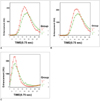1. Prokop M. Multislice CT angiography. Eur J Radiol. 2000. 36:86–96.
2. Cademartiri F, Van der Lugt A, Luccichenti G, Pavone P, Krestin GP. Parameters affecting bolus geometry in CTA: a review. J Comput Assist Tomogr. 2002. 26:598–607.
3. Kim T, Murakami T, Takahashi S, Tsuda K, Tomoda K, Narumi Y, et al. Effects of injection rates of contrast material on arterial phase hepatic CT. AJR Am J Roentgenol. 1998. 171:429–432.
4. Sheafor DH, Keogan MT, DeLong DM, Nelson RC. Dynamic helical CT of the abdomen: prospective comparison of pre- and postprandial contrast enhancement. Radiology. 1998. 206:359–363.
5. Garcia P, Genin G, Bret PM, Bonaldi VM, Reinhold C, Atri M. Hepatic CT enhancement: effect of the rate and volume of contrast medium injection in an animal model. Abdom Imaging. 1999. 24:597–603.
6. Han JK, Kim AY, Lee KY, Seo JB, Kim TK, Choi BI, et al. Factors influencing vascular and hepatic enhancement at CT: experimental study on injection protocol using a canine model. J Comput Assist Tomogr. 2000. 24:400–406.
7. Kopka L, Rodenwaldt J, Fischer U, Mueller DW, Oestmann JW, Grabbe E. Dual-phase helical CT of the liver: effects of bolus tracking and different volumes of contrast material. Radiology. 1996. 201:321–326.
8. Platt JF, Reige KA, Ellis JH. Aortic enhancement during abdominal CT angiography: correlation with test injections, flow rates, and patient demographics. AJR Am J Roentgenol. 1999. 172:53–56.
9. Rubin GD, Paik DS, Johnston PC, Napel S. Measurement of the aorta and its branches with helical CT. Radiology. 1998. 206:823–829.
10. Kirchner J, Kickuth R, Laufer U, Noack M, Liermann D. Optimized enhancement in helical CT: experiences with a real-time bolus tracking system in 628 patients. Clin Radiol. 2000. 55:368–373.
11. Bae KT, Heiken JP, Brink JA. Aortic and hepatic contrast medium enhancement at CT Part 2 Effect of reduced cardiac output in a porcine model. Radiology. 1998. 207:657–662.
12. Kono T, Morita H, Kuroiwa T, Onaka H, Takatsuka H, Fujiwara A. Left ventricular wall motion abnormalities in patients with subarachnoid hemorrhage: neurogenic stunned myocardium. J Am Coll Cardiol. 1994. 24:636–640.
13. Yamashita Y, Komohara Y, Takahashi M, Uchida M, Hayabuchi N, Shimizu T, et al.
. Radiology. 2000. 216:718–723.
14. Bluemke DA, Fishman EK, Anderson JH. Effect of contrast concentration on abdominal enhancement in the rabbit: spiral computed tomography evaluation. Acad Radiol. 1995. 2:226–231.
15. Haage P, Schmitz-Rode T, Hubner D, Piroth W, Gunther RW. Reduction of contrast material dose and artifacts by saline flush using a double power injector in helical CT of the thorax. AJR Am J Roentgenol. 2000. 174:1049–1053.
16. Hittmair K, Fleischmann D. Accuracy of predicting and controlling time-dependent aortic enhancement from test bolus injection. J Comput Assist Tomogr. 2001. 25:287–294.
17. Vergara M, Seguel S. Adverse reactions to contrast media in CT: effects of temperature and ionic property. Radiology. 1996. 199:363–366.
18. Cademartiri F, Mollet NR, Van der Lugt A, McFadden EP, Stijnen T, de Feyter PJ, et al. Intravenous contrast material administration at helical 16-detector row CT coronary angiography: effect of iodine concentration on vascular attenuation. Radiology. 2005. 236:661–665.
19. Knollmann F, Schimpf K, Felix R. Iodine delivery rate of different concentrations of iodine-containing contrast agents with rapid injection. Rofo. 2004. 176:880–884.
20. Halsell RD. Heating contrast media in a microwave oven. Radiology. 1987. 163:279–280.
